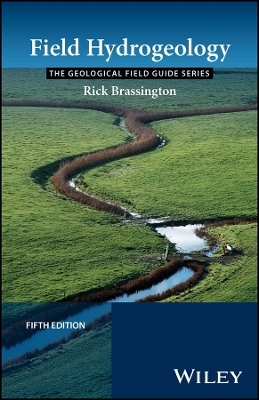
Field Hydrogeology
John Wiley & Sons Inc (Verlag)
978-1-394-18062-2 (ISBN)
The fully revised Fifth Edition of Field Hydrogeology serves as a comprehensive guide to conducting a hydrogeological study, beautifully presented with full colour photos and diagrams throughout, in a practical pocket size for easy use in the field. This new edition includes recent developments in the environmental regulations, with particular focus on the use of innovative technology.
New topics in the Fifth Edition include the monitoring of boreholes using piezometers, how to identify the origin of water in the basement of a building, and an expanded section on geothermal energy. The text also includes case studies and text boxes to aid in reader comprehension, with a particular emphasis on practical application throughout.
The Fifth Edition of Field Hydrogeology addresses key topics such as:
Horizontal wells and shallow aquifers
Complicated flow rates through the unsaturated zone
The use of tritium, chlorofluorocarbons and sulphur hexafluoride in recharge studies
Cleaning of boreholes using hydrogen peroxide and oxalic acid
Field Hydrogeology is an essential tool for undergraduate and postgraduate students in Geology, Earth Sciences, Hydrogeology and Engineering courses who are learning to conduct fieldwork and need a handy pocket-sized guide to accompany them into the field.
Rick Brassington worked in the UK public water industry for some 24 years before moving into consultancy. He was employed at director level in three major companies before setting up his own consultancy in 1998. He has also been the Visiting Professor of Hydrogeology in the School of Civil Engineering and Geosciences at Newcastle University since 2007.
Preface to the Fifth Edition viii
Preface to the Fourth Edition ix
Acknowledgements x
1 Introduction 1
1.1 Groundwater Systems 1
1.2 Conceptual Model 4
1.3 Groundwater Computer Modelling 8
1.4 Hydrogeological Report Writing 9
1.5 Expert Witness 9
2 Desk Study 13
2.1 Defining the Area 13
2.2 Identifying the Aquifers 14
2.3 Groundwater Levels 15
2.4 Surface Water 17
2.5 Recharge 17
2.6 Groundwater Use 18
2.7 Groundwater Chemistry 18
2.8 Aerial Photographs and Satellite Imagery 19
2.9 Planning a Fieldwork Programme 20
3 Field Evaluation of Aquifers 23
3.1 Grain Size Analysis 23
3.2 Hydraulic Properties of Aquifers 25
3.3 Hydraulic Properties and Rock Types 27
3.4 Assessing Hydraulic Properties 33
3.5 Using Hydraulic Property Information 34
3.6 Recharge through the Vadose Zone 38
4 Groundwater Levels 45
4.1 Water Level Dippers 45
4.2 Continuous Water Level Recorders 48
4.3 Measuring Ground Levels and Locations 53
4.4 Tool-Box 56
4.5 Well Catalogue 57
4.6 Field Surveys for Wells, Boreholes and Springs 57
4.7 Interpretation of Abstraction Borehole Water Levels 62
Case History 1 – Interpretation of Groundwater Strikes 66
4.8 Groundwater-Level Monitoring Networks 70
Case History 2 – Groundwater-Level Interpretation 70
4.9 Groundwater-Level Fluctuations 71
4.10 Managing Groundwater-Level Data 78
4.11 Constructing Groundwater Contour Maps and Flow Nets 79
4.12 Interpretation of Contour Maps and Flow Nets 82
4.13 Using Other Groundwater Information 83
5 Rainfall, Springs and Streams 85
5.1 Precipitation 85
5.2 Evaporation 89
5.3 Springs 91
Case History 3 – Measuring Flows with Low Heads 92
5.4 Stream-Flow Measurement 98
5.5 Stage–Discharge Relationships 107
5.6 Choosing the Best Method 109
5.7 Processing Flow Data 109
6 Pumping Tests 111
6.1 What Is a Pumping Test? 111
6.2 Planning a Pumping Test 112
6.3 Pumps and Pumping 113
6.4 On-Site Measurements 116
6.5 Pre-Test Monitoring 121
6.6 Test Set-up 121
6.7 Step Tests 123
6.8 Constant Rate Tests 123
6.9 Recovery Tests 125
6.10 Pumping Test Analysis 125
6.11 Tests on Single Boreholes 134
6.12 Packer Tests 137
7 Groundwater Chemistry 141
7.1 Analytical Suites and Determinands 141
7.2 Sampling Equipment 142
7.3 Sampling Protocols 153
7.4 Monitoring Networks 160
7.5 Using Chemical Data 161
8 Recharge Estimation 165
8.1 Water Balance 165
8.2 Rainfall Recharge 167
8.3 Induced Recharge 168
8.4 Other Sources of Recharge 170
9 Specialist Techniques 171
9.1 Borehole and Piezometer Installation 171
9.2 Down-Hole Geophysics 177
Case History 4 – The Use of Borehole Geophysics 178
9.3 Using Artificial Tracers 181
Case History 5 – The Use of Groundwater Tracers 182
10 Practical Applications 189
10.1 Borehole Prognoses 189
10.2 Groundwater Supplies 190
10.3 Wells in Shallow Aquifers 195
10.4 Contaminated Land Investigations 197
10.5 Landfills and Leachate 198
10.6 Geothermal Energy 201
10.7 Groundwater Lowering by Excavation 202
10.8 Rising Water Tables 206
10.9 Soakaways 208
10.10 Investigating Wetland Hydrology 208
Appendix A Good Working Practice 211
A. 1 Safety Codes 211
A1. 2 Safety Clothing and Equipment 211
A1. 3 Distress Signals 212
A1. 4 Exposure or Hypothermia 212
A1. 5 Heat Exhaustion 213
A1. 6 Working near Wells, Boreholes and Monitoring Piezometers 213
A1. 7 Hygiene Precautions for Water Supplies 213
A1. 8 Trial Pits 214
A1. 9 Electrical Equipment 214
A1.10 Filling Fuel Tanks 214
A1.11 Waste Disposal Sites 214
A1.12 Stream Flow Measurement 214
Appendix B Conversion Factors 217
References 219
Index 225
| Erscheinungsdatum | 13.10.2023 |
|---|---|
| Reihe/Serie | Geological Field Guide |
| Verlagsort | New York |
| Sprache | englisch |
| Maße | 145 x 215 mm |
| Gewicht | 369 g |
| Themenwelt | Naturwissenschaften ► Biologie ► Ökologie / Naturschutz |
| Naturwissenschaften ► Geowissenschaften ► Hydrologie / Ozeanografie | |
| Technik ► Bauwesen | |
| ISBN-10 | 1-394-18062-4 / 1394180624 |
| ISBN-13 | 978-1-394-18062-2 / 9781394180622 |
| Zustand | Neuware |
| Informationen gemäß Produktsicherheitsverordnung (GPSR) | |
| Haben Sie eine Frage zum Produkt? |
aus dem Bereich


